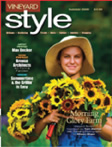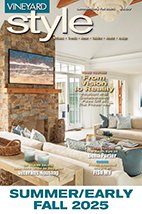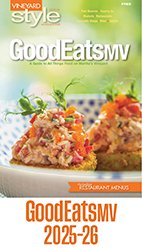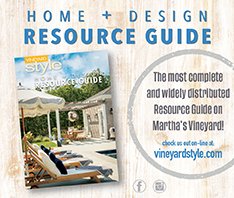ARTIST PROFILE
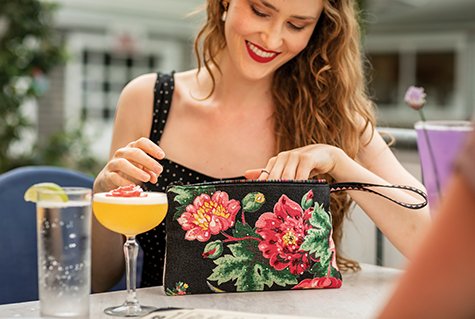
Timeless Vintage Elegance
The Barkcloth Treasures of Sylvie Farrington
By Amelia Smith, Photography Randi Baird, Model & Styling by Nellie Blue
Vintage “ barkcloth” is a cotton upholstery fabric that gets its name from its textured surface. Printed with distinctive, brightly colored mid century designs, it’s made for heavy wear. Twenty five years ago, Sylvie Farrington started making bags out of this spe-cial fabric, and her work has brought joy to her customers ever since. Her bags and pillows bring the cheerful, exuberant designs of barkcloth back into style, while evoking memories of her customers’ childhoods.
Sylvie draws on skills learned during her three-year apprenticeship in Germany and business acumen she picked up from mentors on the Vineyard and beyond, and a lifelong love of fabric.
Sylvie discovered barkcloth in 1996, when she and her then-boyfriend, now husband Paul Farrington, went on a weekend trip to the Brimfield Antique Flea Market, a five-day event that hap-pens three times a year. “We just went for fun, and there was a lady there with a whole table full of barkcloth. I bought a few of her pieces and brought them home and the first SylvieBag was born!” she says. Ever since, Sylvie has been scouring antique textile markets and more, col-lecting the increasingly rare fabric. “It’s a mid-century aesthetic, but it’s a timeless style, it really speaks to me,” Sylvie says. “A lot of my customers remember this fabric being on their grandmothers’ couches. When I look at barkcloth, I choose what I like in terms of the colors and design, and very importantly, I only buy it in mint condition. Sometimes my clients worry that the fabric may not be durable due to its vintage nature, but it’s very strong and well-made.”
The cloth has its own following: certain prints are rare and prized, with seascapes, animals, and farmyard scenes especially sought-after. Sylvie keeps a whole palette of fabric on hand in her basement studio. “This here is my little piece of heaven” she says of her studio. A wide worktable sits in the middle, with three sturdy, professional sewing machines and an overlock machine to one side. She spends a lot of time there, in front of a wall of fabric, folded and arranged on deep shelves in a rainbow of colors. More fabric sits in totes in another part of the basement, ready to work with because Sylvie has soaked, washed, and machine dried each piece to get it ready for sewing. There are half-made bags ready to be sewn togeth-er, with shiny beads attached to one side, embroidered on with fishing line for strength by Sylvie’s long term assis-tant and good friend Elizabeth Greene of West Tisbury.
Each piece is made to last. Sylvie’s skill in the craft, and as an artist, was built on years of hard work with guid-ance and inspiration from teachers and mentors both on the Vineyard and in her native Germany. Her father was one of her first inspirations. “My dad, who is 92, now, is an artist full time. He is a strong spirit and an entrepreneur, and he modeled what it was like to make a living as an artist,” she says. “Growing up in an artists’ home was something that shaped me a lot.” Her father still makes art every day, and Sylvie’s mother supported him in many practical ways.
After Sylvie graduated from the German equivalent of high school at the age of 18, the opportunity to come to America presented itself. Her best friend, Stine, had hosted an exchange student from Chilmark, and when Stine came to spend the summer on the Vineyard, Sylvie tagged along. The Chilmark family hosted three German teenagers that summer, along with their own two teens, and Sylvie sold newspa-pers on the porch of the Chilmark store, getting to know people here and learn-ing the language. She says that she spoke only rudimentary English when she arrived, but after decades of living here the language seems to come easily to her. After that first summer in Chilmark she didn’t want to go back home, so she found a job as a live-in au pair for the Abrams family. “They treat-ed me like a family member and they gave me a foundation,” Sylvie says.
“And I started noticing how much sense of community there is on Martha’s Vineyard. I just had the feeling that I wanted to live here and be here.”
Staying on the Vineyard permanently wasn’t feasible right away. Sylvie didn’t have a green card, and also knew that she had more to learn. She wanted to learn a solid trade, so going back to Germany to train was the logical choice. She returned to her native Bremen to apprentice as a tailor. German appren-ticeships last three years and come with strict rules about pay and hours.” Sylvie says. In Bremen, there was a shortage of tailors who wanted to take in appren-tices at that time, so the city created a program in a school taught by a master seamstress. Sylvie joined the program as part of a class of fifteen apprentices. For three years, she attended the classes during the school year. A detailed log-book, updated every week, shows the progress of her work as she learned all the techniques of a thoroughly trained seamstress. Her final exam was to make a very complicated dress in a timed test.
It was a rigorous and sometimes difficult program, and Sylvie says that she wasn’t the star student. Halfway through the program the instructor took Sylvie aside and suggested that she drop out, and take up a different trade. The master seamstress thought Sylvie was too slow, and that she wouldn’t succeed as a seamstress. But the teacher didn’t have the power to expel students, and Sylvie didn’t want to give up. “I didn’t know what else I could do that could bring me so much joy,” she says. “I just love fabric.” Now, many years later, she is still working as a seamstress and designer, while most of her classmates from the program have pivoted to other lines of work.
Throughout the apprenticeship program, Sylvie spent her summer vacations on the Vineyard, still working for the Abrams family, and when she graduated she returned to live here year-round. As a skilled sewer, she was very much in demand in a way that she wouldn’t have been in Germany, where her specialized skills were more com-mon. For years, she worked for Michèle Ratté, sewing velvet scarves and later working as her production manager.
“She gave me so much responsibility in my early 20s,” Sylvie says of Michèle.
Sylvie participated in trade shows in New York for Michèle and learned all about the accessories business. Michele also sponsored Sylvie for a green card, which she eventually got through marriage, an easier process. Later, Sylvie sewed for Valerie Beggs of Woodland Waders, another well-known local designer at the time.
For six years, Sylvie and her husband had a caretaking job in Edgartown, and it was during that time that she started making her bags. She worked in her home there, and traveled to shows to sell her work at fine retail crafts shows all over the northeast. “I was a nomad with a big van,” she says. “I was on the road a lot and made many friends, it was a really nice community of artisans.” Meanwhile, Sylvie, her husband, and another couple started working with John Abrams to establish Island Cohousing. It took about five years for the group to bring together the people they needed and to gather the down payment for a mortgage on the land. Island Cohousing has been her home ever since, and settling in there allowed her to start helping oth-ers. She and her husband fostered a local child and later adopted her.
Having a child at home meant staying closer to home, but Sylvie’s cus-tomers could be found on the island, too. Andrea Rogers established the Vineyard Artisans shows in the mid 1990s, and those shows have been very important to Sylvie and other local artisans. “Andrea has done so much to support independent artists, and she’s so dedicated and has created such a com-munity of artisans,” Sylvie says. In the early 2000s, the Vineyard Artisans shows became Sylvie’s main sales venue. Having the business in her home and selling locally gave her the flexibility she needed to take care of her daughter.
When the Artisans Festivals were suspended for a year during 2020, Sylvie got a break from her routine business and a chance to reflect on her many years of work. She also had time to develop an e-commerce website and new ideas for bag styles. Her latest product is a reusable market bag, made of upcycled fabric. It can, “save the planet twice,” by using upcycled materials and also by being a reusable market bag. Another new product is a fun soccerball shaped pillow that celebrates the many patterns of barkcloth and Vintage cut velvet and her quarter-century in business.
“Being in business for twenty five years doing the same thing could be challenging, but I have created a following of women who really appreciate what I do, and come back every year,” Sylvie says. “I think people respond to authenticity. The fabrics are authentic and I don’t copy anyone’s bag designs.
I think it’s important to stay true to yourself,” she says. “It feels like such a privilege to be able to do what I love, and that people treasure it so much. I feel lucky that I am able to inspire such joy in my customers, and I am beyond grateful for everyone who has supported me along the way to make a life on Martha’s Vineyard.
For more information, updates, and shopping, go to: sylviebags.com
Sylvie draws on skills learned during her three-year apprenticeship in Germany and business acumen she picked up from mentors on the Vineyard and beyond, and a lifelong love of fabric.
Sylvie discovered barkcloth in 1996, when she and her then-boyfriend, now husband Paul Farrington, went on a weekend trip to the Brimfield Antique Flea Market, a five-day event that hap-pens three times a year. “We just went for fun, and there was a lady there with a whole table full of barkcloth. I bought a few of her pieces and brought them home and the first SylvieBag was born!” she says. Ever since, Sylvie has been scouring antique textile markets and more, col-lecting the increasingly rare fabric. “It’s a mid-century aesthetic, but it’s a timeless style, it really speaks to me,” Sylvie says. “A lot of my customers remember this fabric being on their grandmothers’ couches. When I look at barkcloth, I choose what I like in terms of the colors and design, and very importantly, I only buy it in mint condition. Sometimes my clients worry that the fabric may not be durable due to its vintage nature, but it’s very strong and well-made.”
The cloth has its own following: certain prints are rare and prized, with seascapes, animals, and farmyard scenes especially sought-after. Sylvie keeps a whole palette of fabric on hand in her basement studio. “This here is my little piece of heaven” she says of her studio. A wide worktable sits in the middle, with three sturdy, professional sewing machines and an overlock machine to one side. She spends a lot of time there, in front of a wall of fabric, folded and arranged on deep shelves in a rainbow of colors. More fabric sits in totes in another part of the basement, ready to work with because Sylvie has soaked, washed, and machine dried each piece to get it ready for sewing. There are half-made bags ready to be sewn togeth-er, with shiny beads attached to one side, embroidered on with fishing line for strength by Sylvie’s long term assis-tant and good friend Elizabeth Greene of West Tisbury.
Each piece is made to last. Sylvie’s skill in the craft, and as an artist, was built on years of hard work with guid-ance and inspiration from teachers and mentors both on the Vineyard and in her native Germany. Her father was one of her first inspirations. “My dad, who is 92, now, is an artist full time. He is a strong spirit and an entrepreneur, and he modeled what it was like to make a living as an artist,” she says. “Growing up in an artists’ home was something that shaped me a lot.” Her father still makes art every day, and Sylvie’s mother supported him in many practical ways.
After Sylvie graduated from the German equivalent of high school at the age of 18, the opportunity to come to America presented itself. Her best friend, Stine, had hosted an exchange student from Chilmark, and when Stine came to spend the summer on the Vineyard, Sylvie tagged along. The Chilmark family hosted three German teenagers that summer, along with their own two teens, and Sylvie sold newspa-pers on the porch of the Chilmark store, getting to know people here and learn-ing the language. She says that she spoke only rudimentary English when she arrived, but after decades of living here the language seems to come easily to her. After that first summer in Chilmark she didn’t want to go back home, so she found a job as a live-in au pair for the Abrams family. “They treat-ed me like a family member and they gave me a foundation,” Sylvie says.
“And I started noticing how much sense of community there is on Martha’s Vineyard. I just had the feeling that I wanted to live here and be here.”
Staying on the Vineyard permanently wasn’t feasible right away. Sylvie didn’t have a green card, and also knew that she had more to learn. She wanted to learn a solid trade, so going back to Germany to train was the logical choice. She returned to her native Bremen to apprentice as a tailor. German appren-ticeships last three years and come with strict rules about pay and hours.” Sylvie says. In Bremen, there was a shortage of tailors who wanted to take in appren-tices at that time, so the city created a program in a school taught by a master seamstress. Sylvie joined the program as part of a class of fifteen apprentices. For three years, she attended the classes during the school year. A detailed log-book, updated every week, shows the progress of her work as she learned all the techniques of a thoroughly trained seamstress. Her final exam was to make a very complicated dress in a timed test.
It was a rigorous and sometimes difficult program, and Sylvie says that she wasn’t the star student. Halfway through the program the instructor took Sylvie aside and suggested that she drop out, and take up a different trade. The master seamstress thought Sylvie was too slow, and that she wouldn’t succeed as a seamstress. But the teacher didn’t have the power to expel students, and Sylvie didn’t want to give up. “I didn’t know what else I could do that could bring me so much joy,” she says. “I just love fabric.” Now, many years later, she is still working as a seamstress and designer, while most of her classmates from the program have pivoted to other lines of work.
Throughout the apprenticeship program, Sylvie spent her summer vacations on the Vineyard, still working for the Abrams family, and when she graduated she returned to live here year-round. As a skilled sewer, she was very much in demand in a way that she wouldn’t have been in Germany, where her specialized skills were more com-mon. For years, she worked for Michèle Ratté, sewing velvet scarves and later working as her production manager.
“She gave me so much responsibility in my early 20s,” Sylvie says of Michèle.
Sylvie participated in trade shows in New York for Michèle and learned all about the accessories business. Michele also sponsored Sylvie for a green card, which she eventually got through marriage, an easier process. Later, Sylvie sewed for Valerie Beggs of Woodland Waders, another well-known local designer at the time.
For six years, Sylvie and her husband had a caretaking job in Edgartown, and it was during that time that she started making her bags. She worked in her home there, and traveled to shows to sell her work at fine retail crafts shows all over the northeast. “I was a nomad with a big van,” she says. “I was on the road a lot and made many friends, it was a really nice community of artisans.” Meanwhile, Sylvie, her husband, and another couple started working with John Abrams to establish Island Cohousing. It took about five years for the group to bring together the people they needed and to gather the down payment for a mortgage on the land. Island Cohousing has been her home ever since, and settling in there allowed her to start helping oth-ers. She and her husband fostered a local child and later adopted her.
Having a child at home meant staying closer to home, but Sylvie’s cus-tomers could be found on the island, too. Andrea Rogers established the Vineyard Artisans shows in the mid 1990s, and those shows have been very important to Sylvie and other local artisans. “Andrea has done so much to support independent artists, and she’s so dedicated and has created such a com-munity of artisans,” Sylvie says. In the early 2000s, the Vineyard Artisans shows became Sylvie’s main sales venue. Having the business in her home and selling locally gave her the flexibility she needed to take care of her daughter.
When the Artisans Festivals were suspended for a year during 2020, Sylvie got a break from her routine business and a chance to reflect on her many years of work. She also had time to develop an e-commerce website and new ideas for bag styles. Her latest product is a reusable market bag, made of upcycled fabric. It can, “save the planet twice,” by using upcycled materials and also by being a reusable market bag. Another new product is a fun soccerball shaped pillow that celebrates the many patterns of barkcloth and Vintage cut velvet and her quarter-century in business.
“Being in business for twenty five years doing the same thing could be challenging, but I have created a following of women who really appreciate what I do, and come back every year,” Sylvie says. “I think people respond to authenticity. The fabrics are authentic and I don’t copy anyone’s bag designs.
I think it’s important to stay true to yourself,” she says. “It feels like such a privilege to be able to do what I love, and that people treasure it so much. I feel lucky that I am able to inspire such joy in my customers, and I am beyond grateful for everyone who has supported me along the way to make a life on Martha’s Vineyard.
For more information, updates, and shopping, go to: sylviebags.com

